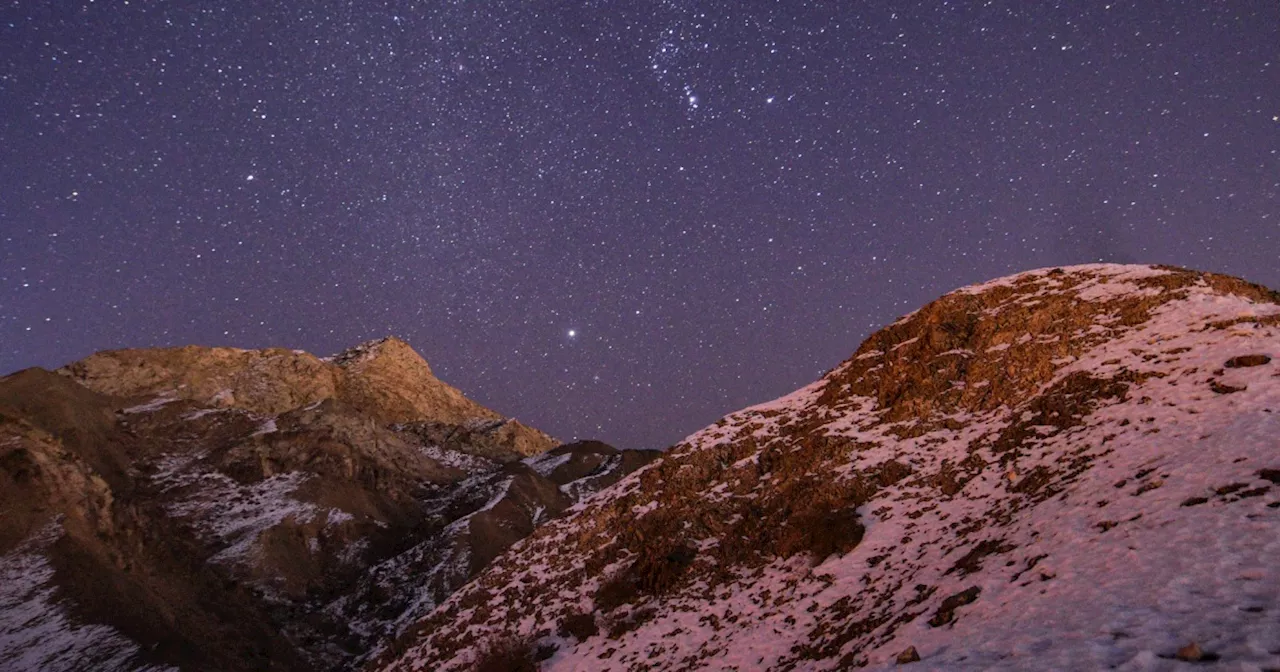The Quadrantid meteor shower, known for its potential to produce bright fireballs, reaches its peak on Friday, offering skywatchers a celestial treat.
When the Quadrantid meteor shower peaks on Friday, it will be the year's first chance to see fireballs in the sky.A waning crescent moon means good visibility under clear and dark conditions.Most meteor shower s are named for the constellations where they appear to originate from in the night sky. But the Quadrantids “take their name from a constellation that doesn’t exist anymore,” said NASA's William Cooke.
These meteors usually don't have long trains, but the heads may appear as bright fireballs. The peak may reveal as many as 120 meteors per hour, according to NASA.Viewing lasts until Jan. 16. The source of the Quadrantids is debris from the asteroid 2003 EH1.When these fast-moving space rocks enter Earth's atmosphere, the debris encounters new resistance from the air and becomes very hot, eventually burning up.Sometimes the surrounding air glows briefly, leaving behind a fiery tail — the end of a 'shooting star.'You don’t need special equipment to see the various meteor showers that flash across annually, just a spot away from city lights.The best time to watch a meteor shower is in the early predawn hours, when the moon is low in the sky.Competing sources of light — such as a bright moon or artificial glow — are the main obstacles to a clear view of meteors. Cloudless nights when the moon wanes smallest are optimal viewing opportunities.And keep looking up, not down. Your eyes will be better adapted to spot shooting stars if you aren’t checking your phone.The Quadrantids will peak on a night with a slim crescent moon, just 11% full
METEOR SHOWER QUADRANTIDS FIREBALLS ASTRONOMY SPACE
United States Latest News, United States Headlines
Similar News:You can also read news stories similar to this one that we have collected from other news sources.
 Quadrantid Meteor Shower Peaks This WeekThe annual Quadrantid meteor shower will peak just in time to ring in the New Year, offering hundreds of 'fireballs' visible to even casual astronomy enthusiasts.
Quadrantid Meteor Shower Peaks This WeekThe annual Quadrantid meteor shower will peak just in time to ring in the New Year, offering hundreds of 'fireballs' visible to even casual astronomy enthusiasts.
Read more »
 Quadrantid Meteor Shower Peaks This WeekThe year's first meteor shower, the Quadrantids, will peak on Friday, offering a chance to see fireballs in the night sky. A waning crescent moon will provide good visibility.
Quadrantid Meteor Shower Peaks This WeekThe year's first meteor shower, the Quadrantids, will peak on Friday, offering a chance to see fireballs in the night sky. A waning crescent moon will provide good visibility.
Read more »
 Quadrantid Meteor Shower Peaks This WeekendThe Quadrantid meteor shower, named after a constellation no longer recognized, peaks this weekend. NASA predicts up to 120 meteors per hour.
Quadrantid Meteor Shower Peaks This WeekendThe Quadrantid meteor shower, named after a constellation no longer recognized, peaks this weekend. NASA predicts up to 120 meteors per hour.
Read more »
 Quadrantid Meteor Shower Peaks This WeekThe Quadrantid meteor shower, the first major meteor shower of the year, will peak on Friday night. While the shower is named after a constellation that no longer exists, skywatchers can expect to see up to 120 meteors per hour during the peak.
Quadrantid Meteor Shower Peaks This WeekThe Quadrantid meteor shower, the first major meteor shower of the year, will peak on Friday night. While the shower is named after a constellation that no longer exists, skywatchers can expect to see up to 120 meteors per hour during the peak.
Read more »
 Quadrantid Meteor Shower Peaks on New Year's DayWitness the first meteor shower of 2025, the Quadrantids, peaking early Friday morning. This annual shower offers a celestial spectacle with bright, colorful meteors visible from the Northern Hemisphere.
Quadrantid Meteor Shower Peaks on New Year's DayWitness the first meteor shower of 2025, the Quadrantids, peaking early Friday morning. This annual shower offers a celestial spectacle with bright, colorful meteors visible from the Northern Hemisphere.
Read more »
 Quadrantid meteor shower peaks this FridayThe Quadrantid meteor shower, named after a constellation that no longer exists, will peak on Friday, offering the first chance this year to see fireballs in the sky. The shower originates from debris left by the asteroid 2003 EH1.
Quadrantid meteor shower peaks this FridayThe Quadrantid meteor shower, named after a constellation that no longer exists, will peak on Friday, offering the first chance this year to see fireballs in the sky. The shower originates from debris left by the asteroid 2003 EH1.
Read more »
